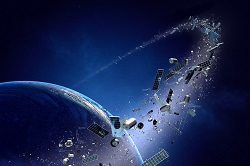Giving Earth’s lower orbit a spring clean
The space community has been aware for some time that close to 2 500 tons of debris currently orbits our planet, and has been looking into innovative solutions to remedy the situation. However, the sheer range of debris sizes and orbits mean that different removal technologies are required, and it remains unclear exactly who will pay for such an ambitious undertaking. It is evident however that this is an issue that urgently needs to be tackled in order to ensure the safe continuation of space exploration. ‘The amount of space debris orbiting the Earth has become dangerous,’ says LEOSWEEP project coordinator Mercedes Ruiz from SENER in Spain. ‘In the last decade alone there have been at least two collisions between spacecraft in the low Earth orbit environment and the probability of more collisions is ever-increasing. This debris poses a real risk to existing and future space missions as well as to assets and people on Earth.’ Debris removal by ion beam The EU-funded LEOSWEEP project sought to address this threat by focusing on the development of a specific 'Active debris removal' (ADR) technique, called the 'Ion beam shepherd' (IBS) concept. This concept was selected based on its suitability to contactless removal of some of the large number of discarded rocket stages that orbit our planet. By deorbiting this debris using IBS, the project team calculated that they could potentially eliminate hundreds of tons of space debris with a few missions. ‘IBS uses ion beams as an efficient and low-risk contactless way of manipulating the debris to be deorbited,’ explains Ruiz. ‘The orbit and / or attitude of a generic object can be changed through the momentum transfer of one or more ion beams produced by 'Electric propulsion' (EP) thrusters on board a nearby spacecraft.’ The technical challenges of IBS were investigated by the LEOSWEEP team, and proposed designs then validated through dedicated simulations implementing detailed models of the ion beams used for actuation on the target as well as the ion beam-target dynamic interaction. Ground-based laboratory experiments were also carried out. A key outcome of all this hard work has been the development of a dedicated low divergence ion thruster (ITT). ‘While ion thrusters have been known and used for spacecraft propulsion for many years, the ITT designed for the LEOSWEEP project is a new design,’ says Ruiz. ‘We were able to demonstrate that this can be used for specific IBS tasks.’ Clearing a path for implementation Next, regulatory and legal framework issues were addressed and the way forward proposed in order to implement a first IBS ADR mission to remove a Ukrainian upper stage rocket. ‘Continuation of this work will now require the involvement of various space agencies, European Commission and Ukrainian authorities, in order to determine if the proposed solution matches their needs,’ points out Ruiz. ‘If so, then the next issue will be how to fund this expedition.’ By demonstrating the technological, economic and legal feasibility of this IBS technique, the LEOSWEEP project hopes to kick-start large-scale active debris removal activities in Ukraine, Europe and other space faring nations in the future. ‘Project partners have also been able to improve their abilities to implement other proposed solutions in the future,’ says Ruiz. ‘For instance, some missions that could benefit from our achievements include formation and tandem flying missions – which will be very important in the coming years – and asteroid deflection and retrieval missions.’



